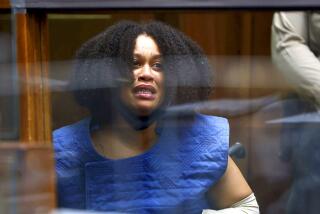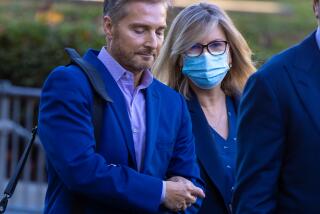Final Moments of Princess Reported
PARIS — A dazed Princess Diana spoke to emergency workers as she lay dying in a mangled Mercedes, moaning “Leave me alone” as they struggled to keep her alive, a French newspaper said Wednesday.
Le Parisien, which has published some of the most detailed reports on the early morning car wreck that cost the princess her life Aug. 31, also said Diana’s ambulance took an hour to get from the crash site to La Pitie-Salpetriere Hospital about four miles away--so long, the paper said, that waiting officials feared that it was lost.
And prosecutors confirmed Wednesday that in addition to being legally drunk, the 41-year-old chauffeur of Diana’s limousine had taken Prozac or other antidepressant pills that could have impaired his driving even more. The driver died in the crash.
French authorities have not yet issued a complete report on the events surrounding the accident. But on Wednesday, in a harrowing reconstruction of Diana’s last hours, Le Parisien said she was so badly hurt that the ambulance taking her to the emergency room drove no faster than 25 mph for fear of injuring her further.
Le Parisien’s account, more complete in some respects than preceding reconstructions, contradicted some earlier reports of Diana’s condition after the crash.
The newspaper quoted an emergency doctor, the first to treat Diana in the underpass beneath the Place de l’Alma, as saying, “She was very agitated, half KOd, but conscious. . . . All around her, there were photographers who were machine-gunning [taking rapid-fire photographs]. They were only a few centimeters from her face, taking her picture from every angle.”
Diana reportedly sighed, struggled weakly and muttered a few times, “Oh my God!” Her face was “intact,” and two wounds were visible elsewhere, one on the thigh and an arm “in tatters,” the physician was quoted as saying.
Meanwhile, Diana’s companion, 41-year-old Dodi Fayed, had been thrown from the Mercedes and lay 20 yards from it, Le Parisien said. Doctors attempted a heart massage on him to no avail.
The scene, as painted by Le Parisien, was this: Diana was half-pulled from the wrecked four-door sedan, though her feet were still on the rear seat. Ten firefighters stood by as the medical workers, who had just arrived, attempted to give her first aid. They had just learned that the young, injured woman in jeans was the princess of Wales.
Just before medical workers clamped an oxygen mask to her face, Diana murmured in English, “Leave me alone. Leave me alone,” the newspaper said. She then slipped into unconsciousness.
Suspecting that she had suffered massive internal bleeding, the doctors inserted a catheter into a vein leading to her heart so that large amounts of blood could be transfused into her. Diana was eased into an ambulance and given two motorcycle police officers as escorts.
Approaching the bridge over the Seine near the Austerlitz train station in eastern Paris, doctors noticed that Diana was losing blood pressure, and her heartbeat was failing. Though very near the hospital, the ambulance had to halt when the princess’ heart stopped beating so she could be given a massive dose of Adrenalin. The motorcycle escort, too fast for the ambulance, lost track of it.
At La Pitie-Salpetriere, which specializes in emergency cases and cardiovascular medicine, Diana’s heart stopped again. Doctors only then discovered the full extent of her wounds. A small but vital pulmonary vein had broken, the newspaper said, and almost a gallon and a half of blood--much of what her body had contained--had spilled into her rib cage area.
Doctors desperately tried to stitch the crucial vein back together, but it was too late.
The account of the slow-moving ambulance ride seemed certain to amplify rising criticism in Britain that Diana was not given the best of emergency care.
Some medical experts on the other side of the Channel had praised the French for their actions, noting the extreme gravity of the princess’ wounds. But that was before more details were known.
A second Paris newspaper, Le Monde, sprang to the defense of the rescue and medical workers Wednesday, devoting an entire page to what it termed “facts versus rumors.”
After receiving the first call at 12:26 a.m., about six minutes after the accident, three ambulances were on the scene by 12:40 a.m., Le Monde said. Firefighters had already arrived.
And to rebut charges from incensed British tabloids that the French investigation is moving at a snail’s pace, Le Monde reported that 50 police detectives were put on the case in its earliest hours.
More than 100 eyewitnesses have been interviewed, Le Monde said, and 10 days after the wreck, 30 officers from an elite police unit were still examining what happened.
Meanwhile, doctors consulted Wednesday about the possible side effects of the Mercedes driver’s having mixed alcohol and drugs were not unanimous, but one Paris specialist said the nature of the substances--fluoxetine and tiapride--found in Henri Paul’s body indicated that the Hotel Ritz employee who held Diana’s life in his hands that night was a deeply depressed individual trying to cope with alcohol-induced aggressive tendencies or impulsiveness.
Dr. Denis Puech, a specialist on depression at St. Antoine’s Hospital, said fluoxetine is the active agent in the powerful and popular antidepressant Prozac.
Tiapride, the other drug found during a post-mortem examination of Paul’s body, is the active ingredient in the French sedative Tiapridal, Puech said. Tiapridal is mainly given to people with “behavioral troubles” linked to a chronic drinking habit, including being impulsive or unusually aggressive, he said.
The Vidal, the French physician’s standard desktop reference, says both drugs should be “used with prudence by drivers or people operating machinery.”
In its statement, the prosecutor’s office said the amount of the Prozac drug detected indicated that Paul had been taking it regularly, while lesser levels of tiapride turned up.
The tests, conducted last week in the presence of Investigating Magistrate Herve Stephan, also reconfirmed earlier post-mortems that found that Paul, deputy security chief at the Ritz, had consumed the equivalent of a bottle and a half of wine, and had more than three times the legally permitted limit of alcohol in his blood.
Though French officials have backed off earlier, precise estimates of the speed that Paul was driving, witness accounts have led police to believe that he was going more than 86 mph in a 30-mph zone. When the Mercedes-Benz he was driving rammed into a concrete pillar in an underground tunnel, only the car’s fourth passenger, a bodyguard, survived.
More to Read
Sign up for Essential California
The most important California stories and recommendations in your inbox every morning.
You may occasionally receive promotional content from the Los Angeles Times.










